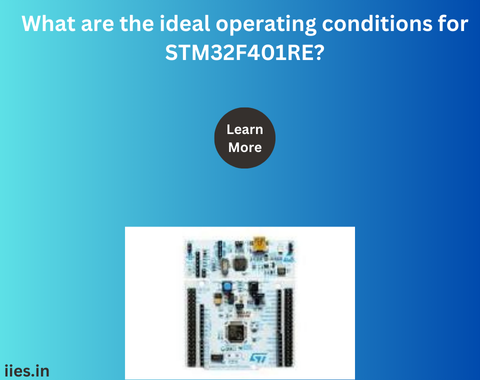
The STM32F401RE is a powerful microcontroller developed by STMicroelectronics, known for its high performance and versatility. To ensure optimal functionality and longevity of the device, it is crucial to adhere to the recommended operating conditions specified by the manufacturer.
In this article, we will explore the key parameters and guidelines that users should consider when working with the STM32F401RE microcontroller.
To achieve this, users should utilize voltage regulators or power management circuits to maintain the voltage within the specified limits.
Additionally, attention should be paid to the power-up and power-down sequences to prevent voltage spikes or drops that could negatively impact the microcontroller.
One of the fundamental operating conditions for the STM32F401RE is the voltage supply. The microcontroller operates within a specified voltage range, typically between 1.7V and 3.6V. Deviating from this range can lead to erratic behavior, data corruption, or even permanent damage to the device. It is essential to provide a stable and clean power supply to ensure reliable operation.
Clock Frequency and Source:
The STM32F401RE relies on an internal or external clock source to synchronize its operations. The microcontroller supports a wide range of clock frequencies, allowing users to optimize performance based on their application requirements. The maximum operating frequency is 84 MHz, and users can choose from various sources, including external crystals or oscillators.
When configuring the clock, it is crucial to consider the system’s timing requirements and the specific peripherals in use. Proper clock configuration not only ensures accurate timing but also contributes to power efficiency. Users should consult the microcontroller’s datasheet and reference manual to select an appropriate clock source and frequency for their applications.
Temperature Range:
The operating temperature range is another critical factor that users must consider when working with the STM32F401RE. The microcontroller is designed to operate within a specified temperature range, typically between -40°C to 85°C or -40°C to 105°C, depending on the device variant. Extreme temperatures beyond these limits can affect the device’s performance and reliability.
In applications where the operating environment may experience temperature extremes, users should implement proper thermal management strategies. This may include the use of heat sinks, thermal pads, or designing the system to allow for adequate heat dissipation. Understanding the thermal characteristics of the microcontroller is essential to prevent overheating and ensure long-term stability.
ESD (Electrostatic Discharge) Protection:
Electrostatic discharge poses a significant threat to the longevity and reliability of electronic components, including the STM32F401RE microcontroller. Implementing proper ESD protection measures is crucial during the handling, assembly, and operation of the device. Users should follow industry best practices and guidelines to minimize the risk of ESD-induced damage.
This may involve using ESD-safe workstations, grounding straps, and packaging materials that provide electrostatic shielding. Additionally, designing the system with ESD protection devices, such as transient voltage suppressors, can further enhance the microcontroller’s resilience to electrostatic discharge.
Current Consumption:
Optimizing power consumption is a key consideration in many embedded systems, particularly those powered by batteries or operating in energy-constrained environments. The STM32F401RE provides various power modes, allowing users to tailor the microcontroller’s current consumption to their specific needs.
Careful consideration should be given to selecting the appropriate power mode based on the application’s operational requirements. For example, low-power modes may be employed during idle periods to extend battery life in energy-efficient applications. Analyzing the current consumption profile at different operating conditions is essential for maximizing energy efficiency.
Input and Output (I/O) Characteristics:
Understanding the input and output characteristics of the STM32F401RE is crucial for designing effective interfaces with external components. The microcontroller supports a variety of digital and analog I/O pins with specific voltage and current requirements. Users must ensure that the signals applied to these pins fall within the specified voltage levels and do not exceed the maximum current ratings.
Proper consideration of the I/O characteristics includes configuring pin modes, pull-up or pull-down resistors, and ensuring that the voltage levels are compatible with the connected devices. This attention to detail helps prevent damage to the microcontroller and ensures reliable communication with external peripherals.
Memory Considerations:
The STM32F401RE features a Flash memory for program storage and SRAM for data storage. Adhering to recommended operating conditions involves managing these memory resources effectively. Users should avoid exceeding the specified program memory size and ensure that data stored in SRAM does not exceed its capacity.
In addition, the microcontroller supports various memory interfaces, such as external Flash or SRAM. When utilizing external memory devices, users must adhere to the recommended operating conditions and timing requirements to maintain data integrity and system stability.
Reset and Startup:
Proper handling of resets and startup sequences is critical for initializing the microcontroller correctly. Users should follow the recommended power-on and power-off sequences to ensure a stable and predictable startup. This includes configuring the reset sources and handling them appropriately in the firmware.
Understanding the reset and startup procedures is essential for avoiding unexpected behavior during power-up or after a system reset. It also contributes to reliable and deterministic operation, particularly in safety-critical applications.
In conclusion, adhering to the recommended operating conditions is essential for maximizing the performance, reliability, and lifespan of the STM32F401RE microcontroller. Voltage supply, clock frequency, temperature range, ESD protection, and current consumption are among the critical parameters that users must carefully manage. By following the guidelines outlined in the datasheet and reference manual, developers can create robust and efficient embedded systems that leverage the full potential of the STM32F401RE microcontroller. As technology continues to advance, staying informed about best practices and updates from the manufacturer ensures that developers can harness the capabilities of these powerful microcontrollers effectively.
Indian Institute of Embedded Systems – IIES